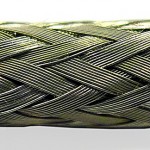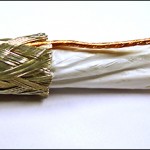Effective Shielding of Cables Part 2
Braided Shields

Example of a braided shield with 95% coverage. 100% coverage is not possible because of spaces between braid
Braided shields provide excellent protection from both high and low frequency interference while maintaining good flexibility and flex life.
A braided shield usually consists of two groups of copper strands woven in opposite directions; one group is applied in a left-hand lay and other in a right-hand lay. Because of this design, a braided shield offers good flexibility.
Most medical cables incorporating a braided shield specify 80 to 95% shield coverage. The higher the percentage of braid coverage, the more effective the EMI shielding is. Coverage of 100% is not possible with a braided shield because leakage will always occur at points where the strands cross each other.
In addition to the percentage of coverage, the tightness of the braid affects performance. A tight braid with a high percentage of coverage does a better job of shielding but makes the cable or wire less flexible. A loose braid offers greater flexibility but with reduced effectiveness of the shield.

A drain wire running the length of the braided shield facilitates termination
Braided shields can be difficult to terminate unless the braid is “combed out and pigtailed – that is combining conductors from both the left and right lay into a single twisted wire.” The extra labor to “comb-out” and terminate a braided shield can add cost to the cable assembly. In some configurations a drain wire running the length of the shield is added to make termination of the shield easier.
When subjected to a high number of flex cycles, a braided shield may breakdown due to the cross lapping strands abrading each other. When this happens the broken strands can damage insulation leading to cable failure. For applications requiring a very high number of flex cycles, a braided shield may not be the best choice.
Next post: Foil shields and a shielding summary